Related Research Articles

Duke of Buckingham and Normanby was a title in the Peerage of England. The full title was Duke of the County of Buckingham and of Normanby but in practice only Duke of Buckingham and Normanby was used. The dukedom was created in 1703 for John Sheffield, 1st Marquess of Normanby KG, a notable Tory politician of the late Stuart period, who served under Queen Anne as Lord Privy Seal and Lord President of the Council. He had succeeded his father as 3rd Earl of Mulgrave in 1658 and been made Marquess of Normanby in 1694.

Marquess of Bath is a title in the Peerage of Great Britain. It was created in 1789 for Thomas Thynne, 3rd Viscount Weymouth. The Marquess holds the subsidiary titles Baron Thynne, of Warminster in the County of Wiltshire, and Viscount Weymouth, both created in 1682 in the Peerage of England. He is also a baronet in the Baronetage of England.

Earl Ferrers is a title in the Peerage of Great Britain. It was created in 1711 for Robert Shirley, 14th Baron Ferrers of Chartley. The Shirley family descends from George Shirley of Astwell Castle, Northamptonshire. In 1611 he was created a Baronet, of Staunton Harold in the County of Leicester, in the Baronetage of England. He was succeeded by his son Henry, the second Baronet, who married Lady Dorothy Devereux, daughter of Robert Devereux, 2nd Earl of Essex. On the death of her brother Robert Devereux, 3rd Earl of Essex, she became the youngest co-heir to the baronies of Ferrers of Chartley and the barony of Bourchier, which had fallen into abeyance on the death of the third Earl. Shirley was succeeded by his eldest son, the third Baronet. He died unmarried and was succeeded by his younger brother, the fourth Baronet. He was imprisoned in the Tower of London by Cromwell and died there in 1656. On his death the title passed to his eldest son, the fifth Baronet. He died at an early age and was succeeded at birth by his posthumous son, the sixth Baronet.
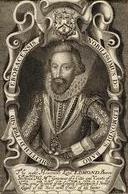
The title Earl of Mulgrave has been created twice. The first time as a title in the Peerage of England and the second time as a Peerage of the United Kingdom.
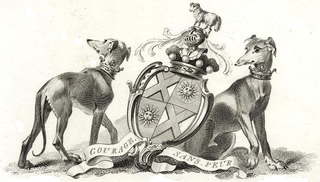
Viscount Gage, of Castle Island in the County of Kerry of the Kingdom of Ireland, is a title in the Peerage of Ireland. It was created in 1720 for Thomas Gage, along with the subsidiary title of Baron Gage, of Castlebar in the County of Mayo, also in the Peerage of Ireland. In 1744 he also succeeded his cousin as eighth Baronet, of Firle Place. The titles remain united. The Gage family descends from John Gage, who was created a baronet, of Firle Place in the County of Sussex, in the Baronetage of England on 26 March 1622. His great-grandson, the seventh Baronet, represented Seaford in Parliament. He was succeeded by his first cousin, Thomas Gage, 1st Viscount Gage, the eighth Baronet. He sat as a Member of Parliament for Minehead and Tewkesbury and also served as Governor of Barbados. In 1720, 24 years before succeeding in the baronetcy, he was raised to the Peerage of Ireland as Baron Gage and Viscount Gage. His second son was the military commander the Hon. Thomas Gage.
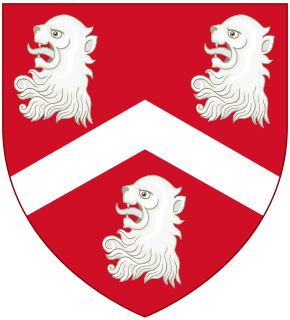
Viscount Monck, of Ballytrammon in the County of Wexford, is a title in the Peerage of Ireland. It was created in 1801 for Charles Monck, 1st Baron Monck. He had already been created Baron Monck, of Ballytrammon in the County of Wexford, in 1797, also in the Peerage of Ireland. His eldest son, the second Viscount, was in 1822 created Earl of Rathdowne in the Peerage of Ireland. However, this title became extinct on his death, while he was succeeded in the other titles by his younger brother, the third Viscount. The latter's son, the fourth Viscount, served as the 1st Governor General of Canada. In 1866, he was given the title Baron Monck, of Ballytrammon in the County of Wexford, in the Peerage of the United Kingdom. This title gave the viscounts a seat in the Westminster House of Lords until the passing of the House of Lords Act 1999. As of 2012 the titles are held by his great-great-grandson, the seventh Viscount, who succeeded his father in 1982. He does not use his titles.
Baron Kensington is a title that has been created three times, in the Peerages of England, Ireland and the United Kingdom.
Baron Congleton, of Congleton in the County Palatine of Chester, is a title in the Peerage of the United Kingdom. It was created in 1841 for the Whig politician and former Secretary at War and Paymaster of the Forces Sir Henry Parnell, 4th Baronet. His eldest son, the second Baron, devoted his life to religious work and was an early member of the Plymouth Brethren. The latter was succeeded by his younger brother, the third Baron. He served in the Royal Navy and fought at the Battle of Navarino in 1827. His eldest surviving son, the fourth Baron, was a major-general in the British Army and served in the Crimean War and in the Anglo-Zulu War. The latter's eldest son, the fifth Baron, was killed in action in Ypres Salient during the First World War and was succeeded by his younger brother, the sixth Baron. As of 2015, the titles are held by the latter's grandson, the ninth Baron, who succeeded his father in 2015.
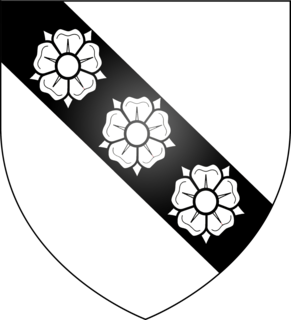
Baron Hunsdon is a title that has been created three times.

Viscount Fauconberg, of Henknowle in the Bishopric of Durham, was a title in the Peerage of England held by the head of the Belasyse family. This family descended from Sir Henry Belasyse, High Sheriff of Yorkshire from 1603 to 1604, who was created a Baronet, of Newborough in the County of York, in the Baronetage of England in 1611. His son, Sir Thomas, the second Baronet, was created Baron Fauconberg, of Yarm in the County of York, in the Peerage of England in 1627. In 1643 he was further honoured when he was made Viscount Fauconberg, of Henknowle in the Bishopric of Durham, also in the Peerage of England. He was succeeded by his grandson, Thomas, the second Viscount, the son of the Honourable Henry Belasyse. Thomas was created Earl Fauconberg in the Peerage of England in 1689. He was childless and the earldom became extinct on his death in 1700. He was succeeded in the remaining titles by his nephew and namesake, Thomas, the third Viscount, the son of Sir Rowland Belasyse. The third Viscount was succeeded by his son, Thomas, the fourth Viscount, who in 1756 was created Earl Fauconberg, of Newborough in the County of York, in the Peerage of Great Britain. The Earl's son Thomas, the second Earl, had no sons and the earldom became extinct on his death in 1802. He was succeeded in the remaining titles by his second cousin Rowland Belasyse, the sixth Viscount, the grandson and namesake of Rowland Belasyse, younger brother of the third Viscount. The sixth Viscount was succeeded by his younger brother, Charles the seventh Viscount, on whose death in 1815 all the titles became extinct.
Earl of Sussex is a title that has been created several times in the Peerages of England, Great Britain, and the United Kingdom. The early Earls of Arundel were often also called Earls of Sussex.
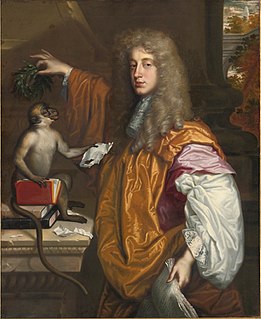
Earl of Rochester was a title that was created twice in the Peerage of England. The first creation came in 1652 in favour of the Royalist soldier Henry Wilmot, 2nd Viscount Wilmot. He had already been created Baron Wilmot, of Adderbury in the County of Oxford, in 1643, also in the Peerage of England. He was the son of Charles Wilmot, who had been elevated to the Peerage of Ireland as Viscount Wilmot, of Athlone, in 1622. Lord Rochester died in 1658 and was succeeded by his son John Wilmot, 2nd Earl of Rochester. He was a poet, a friend of King Charles II, and the writer of satirical and bawdy poetry. He married the heiress Elizabeth Malet. He was succeeded on his death in 1680 by his only son, the third Earl. He died at a young age the following year, when the titles became extinct.

Earl of Cavan is a title in the Peerage of Ireland. It was created in 1647 for Charles Lambart, 2nd Baron Lambart. He was made Viscount Kilcoursie, in the King's County, at the same time, also in the Peerage of Ireland. Lord Cavan was the son of Oliver Lambart, who had been elevated to the Peerage of Ireland as Lord Lambart, Baron of Cavan in the County of Cavan, in 1618.

Baron Hylton is a title that has been created twice, once in the Peerage of England and once in the Peerage of the United Kingdom. The first creation came in the Peerage of England 1295 when Robert Hylton was summoned to the Model Parliament as Lord Hylton by writ. His son, Alexander, was called to Parliament in 1332 and 1335, but no further summons were sent for his descendants. Therefore, the title has only been held de jure after the death of the second baron. Indeed, the last baron was Member of Parliament for Carlisle after "inheriting" the title, due to this anomaly. Despite this, the creation is deemed to have fallen into abeyance on the death of the eighteenth baron without male heirs in 1746.
Viscount Bellomont, in the County of Dublin, was a title in the Peerage of Ireland. It was created on 18 July 1645 for the Royalist soldier Sir Henry Bard, 1st Baronet. He had already been created a Baronet, of Staines in the County of Middlesex, in the Baronetage of England on 8 October 1644, and was made Baron Bard of Dromboy, in the County of Westmeath, at the same time as he was granted the viscountcy, also in the Peerage of Ireland. All three titles became extinct on the early death of his only son, the second Viscount, in 1667.

The title of Baron Herbert of Chirbury was created five times, twice in the Peerage of England, twice in the Peerage of Great Britain and once in the Peerage of the United Kingdom.
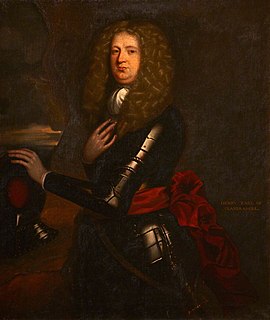
Earl of Clanbrassil was a title that was created twice in the Peerage of Ireland, both times for members of the Hamilton family. Clanbrassil was the name of an old Gaelic territory in what is now the barony of Oneilland East in the north-east of modern County Armagh, Northern Ireland.
Roger Cavan Lambart, 13th Earl of Cavan, is a hereditary peer.
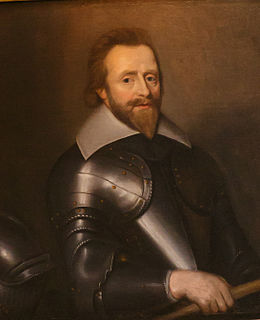
There have been two baronetcies created for members of the Coote family. The first is Coote of Castle Cuffe, while the second is Coote of Donnybrooke, both in the Baronetage of Ireland. As of 2020, the first creation is still extant. The holders of the first creation also held the title of Earl of Mountrath between 1660 and 1802.
Greville Verney, 8th Baron Willoughby de Broke and de jure 16th Baron Latimer was a peer in the peerage of England.